
The Arleigh Burke class of guided-missile destroyers (DDGs) is a United States Navy class of destroyer centered around the Aegis Combat System and the SPY-1D multi-function passive electronically scanned array radar. The class is named for Admiral Arleigh Burke, an American destroyer officer in World War II and later Chief of Naval Operations. With an overall length of 505 to 509.5 feet, displacement ranging from 8,300 to 9,700 tons, and weaponry including over 90 missiles, the Arleigh Burke-class destroyers are larger and more heavily armed than many previous classes of guided-missile cruisers.
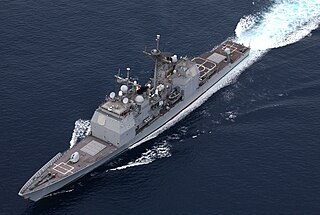
The Aegis Combat System is an American integrated naval weapons system developed by the Missile and Surface Radar Division of RCA, and it is now produced by Lockheed Martin.
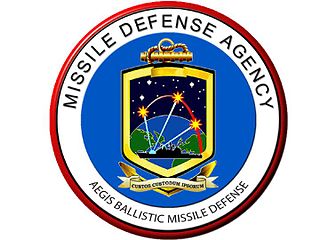
The Aegis Ballistic Missile Defense System, also known as Sea-Based Midcourse, is a United States Department of Defense Missile Defense Agency program developed to provide missile defense against short to intermediate-range ballistic missiles. The program is part of the United States national missile defense strategy and European NATO missile defence system.

USS Lake Erie (CG-70) is a Ticonderoga-class guided missile cruiser of the United States Navy, commissioned in 1993. She was named after the U.S. Navy's decisive victory in the Battle of Lake Erie during the War of 1812. The cruiser was the first U.S. Navy ship to be commissioned in Hawaii.

USS Benfold (DDG-65) is a Flight I Arleigh Burke-class destroyer in the United States Navy. She is a multi-mission platform capable of anti-aircraft warfare (AAW) with the powerful Aegis Combat System suite and anti-aircraft missiles, anti-submarine warfare (ASW), with towed sonar array, anti-submarine rockets, anti-surface warfare (ASUW) with Harpoon missiles, and strategic land strike using Tomahawk missiles. Benfold was one of the first ships fitted with the Aegis Ballistic Missile Defense System and during the 2010 Stellar Daggers exercise was the first ship to simultaneously engage a ballistic missile and a cruise missile.
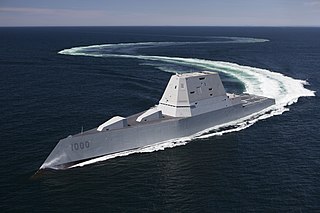
The Zumwalt-class destroyer is a class of three United States Navy guided-missile destroyers designed as multi-mission stealth ships with a focus on land attack. It is a multi-role class that was designed with a primary role of naval gunfire support and secondary roles of surface warfare and anti-aircraft warfare. The class design emerged from the DD-21 "land attack destroyer" program as "DD(X)" and was intended to take the role of battleships in meeting a congressional mandate for naval fire support. The ship is designed around its two Advanced Gun Systems (AGS), turrets with 920 round magazines, and unique Long Range Land Attack Projectile (LRLAP) ammunition. LRLAP procurement was canceled, rendering the guns unusable, so the Navy re-purposed the ships for surface warfare. Starting in 2023, the Navy will remove the AGS from the ships and replace them with hypersonic missiles.

The Kongō class of guided-missile destroyers in the Japan Maritime Self-Defense Force are equipped with the Aegis Combat System, and is the first of few ship classes outside the United States to have that capability. Following a decision made in December 2003, Japan is upgrading their Kongo-class destroyers with Aegis Ballistic Missile Defense System. The upgrade involves a series of installations and flight tests to take place from 2007 to 2010. JS Kongo was the first ship to have the BMD upgrade installed.

The Missile Defense Agency (MDA) is the section of the United States government's Department of Defense responsible for developing a layered defense against ballistic missiles. It had its origins in the Strategic Defense Initiative (SDI) which was established in 1983 by Ronald Reagan and which was headed by Lt. General James Alan Abrahamson. Under the Strategic Defense Initiative's Innovative Sciences and Technology Office headed by physicist and engineer Dr. James Ionson, the investment was predominantly made in basic research at national laboratories, universities, and in industry. These programs have continued to be key sources of funding for top research scientists in the fields of high-energy physics, advanced materials, supercomputing/computation, and many other critical science and engineering disciplines—funding which indirectly supports other research work by top scientists, and which was most politically viable to fund within the Military budget of the United States environment. It was renamed the Ballistic Missile Defense Organization in 1993, and then renamed the Missile Defense Agency in 2002. The current director is U.S. Navy Vice Admiral Jon A. Hill.

The United States Naval Surface Warfare Center Dahlgren Division (NSWCDD), named for Rear Admiral John A. Dahlgren, is located in King George County, Virginia, in close proximity to the largest fleet concentration area in the Navy. NSWCDD is part of the Naval Surface Warfare Centers under the Naval Sea Systems Command (NAVSEA). NSWCDD was initially established 16 October 1918 as a remote extension of Maryland's Indian Head Proving Ground used for testing naval guns. The Dahlgren site was named the Lower Station, Dahlgren Naval Proving Ground when it first opened. The location on the Potomac River was specifically chosen for the development of a long ballistic test range on the Potomac River, required for the testing of modern, high-powered munitions.
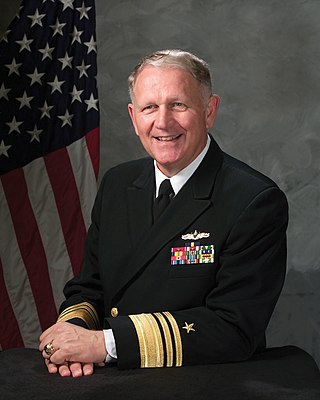
Rodney Paul Rempt is a retired Vice Admiral of the United States Navy who served as the 59th Superintendent of the U.S. Naval Academy from 2003 to 2007.

Rear Admiral Wayne Eugene Meyer is regarded as the "Father of Aegis" for his 13 years of service as the Aegis Weapon System Manager and later the founding project manager of the Aegis Shipbuilding Project Office. He retired from the United States Navy in 1985 as the Deputy Commander for Weapons and Combat Systems, Naval Sea Systems, Naval Sea Systems Command and Ordnance Officer of the Navy.

Admiral John Harold Sides was a four-star admiral in the United States Navy who served as commander in chief of the United States Pacific Fleet from 1960 to 1963 and was known as the father of the Navy's guided-missile program.

The Operational Test and Evaluation Force (OPTEVFOR) serves as an independent and objective agency within the United States Navy for the operational testing and evaluation (OT&E) of naval aviation, surface warfare, submarine warfare, C4I, cryptologic, and space systems in support Navy and U.S. Department of Defense acquisition programs.
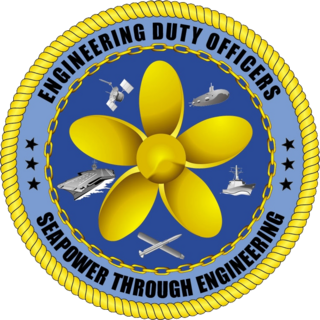
An engineering duty officer (EDO) is a restricted line officer in the United States Navy, involved with the design, acquisition, construction, repair, maintenance, conversion, overhaul and disposal of ships, submarines, aircraft carriers, and the systems installed aboard. As of August 1, 2016, there are approximately 835 engineering duty officers on active duty in the U.S. Navy, representing approximately 2 percent of its active-duty commissioned officers.

The Naval Sea Systems Command (NAVSEA) is the largest of the United States Navy's five "systems commands," or materiel organizations. From a physical perspective, NAVSEA has four shipyards for shipbuilding, conversion, and repair, ten "warfare centers", the NAVSEA headquarters, located at the Washington Navy Yard, in Washington D.C., and other locations in 15 states and 3 overseas continents.

Rear Admiral Nevin Palmer Carr Jr. is a retired U.S. Navy admiral who served as Chief of Naval Research.

Alma M. Grocki is a retired United States Navy rear admiral. After graduating from the United States Naval Academy in 1981, she served in a succession of warship and submarine maintenance postings before transferring to the United States Navy Reserve in 1988. Grocki commanded various U.S. Navy facilities, shipyards and programs before becoming director of fleet maintenance for the United States Pacific Fleet and deputy commander of Naval Sea Systems Command.

The six Naval Sea Systems Command Program Executive Offices(PEOs) are responsible for the development and acquisition of naval platforms and weapons systems. Their mission is to develop, acquire, field and sustain affordable and integrated state of the art equipment for the Navy and Marine Corps.

Rear Admiral Kevin P. Byrne is an active duty United States Navy officer and career surface warfare officer who has been serving as Commander, Naval Surface Warfare Center (NSWC) and Naval Undersea Warfare Center (NUWC) since April 20, 2020.

Jon Anthony Hill is a United States Navy Vice Admiral who serves as the Director of the Missile Defense Agency. Previously, he was the Deputy Director of the same agency. His first Flag Officer assignment was as U.S. Navy Program Executive Officer for Integrated Warfare Systems where he was accountable for surface ship sensors, command and control, and weapons. He has served in multiple combat system and shipbuilding program offices, Naval Surface Warfare Centers, along with tours with the U.S. Army, Joint Staff and the SECNAV Staff. He qualified in Surface Warfare as an ensign aboard USS RICHARD E. BYRD (DDG-23). Born and raised at Fort Bliss, Texas, Hill received a bachelor's degree in biology and chemistry from St. Mary's University and later earned an M.S. degree in applied physics and ordnance engineering from the Naval Postgraduate School.



















